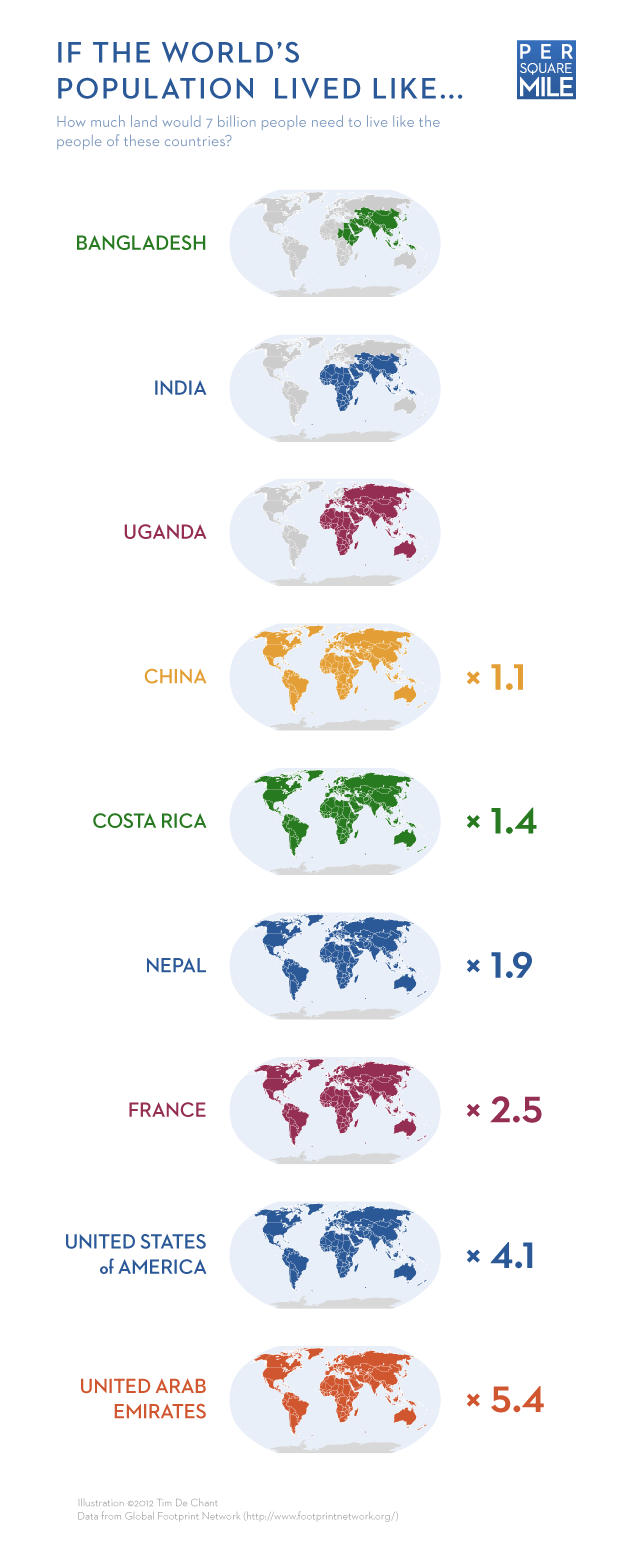How many Earths do we need?
- Published

It has been suggested that if everyone on the planet consumed as much as the average US citizen, four Earths would be needed to sustain them. But where does this claim originate, and how is it calculated?
The world's seven billion people consume varying amounts of the planet's resources. Compare the lifestyle of a subsistence farmer with that of a wealthy city-dweller in a developed country. More land is required to grow the city dweller's food, more materials are used to build the city dweller's home and workplace, more energy is required for transport, heating and cooling.
So it's obvious that Americans consume more, on average, than the people of less developed countries. But the claim that four Earths would be needed if everyone lived like Americans is still a striking one.
It has been recurring on social media at least since 2012, when science writer Tim De Chant produced this infographic, external illustrating how much land would be required if seven billion people lived like the populations of nine selected countries from Bangladesh to the United Arab Emirates.

De Chant was using a subset of data produced by the Global Footprint Network (GFN), which has been attempting the tricky business of measuring the impact of humans on the planet since 2003.
"Ecological footprinting" is where researchers look at how much land, sea and other natural resources are used to produce what people consume - how many potatoes they eat, how much milk they drink, the cotton that goes into the shirts they wear and so on.
They do this by using published statistics on consumption and the amount of land or sea used to produce the quantity of goods consumed.
"It's a book-keeping approach for resources," says GFN director and co-founder Mathis Wackernagel.
The key questions for GFN, he says, are: "If there is one planet - how much planet is available per person and how much planet do we use per person."
The answers are expressed in an unusual unit - the global hectare, defined as a biologically productive hectare with world-average bioproductivity.
The average American, says GFN, uses seven global hectares, compared to a global average of 2.7, according to the most recent GFN figures (based on data from 2011). It's this figure of seven global hectares that allows Wackernagel and his colleagues to calculate that it would take four Earths - or to be precise, 3.9 Earths - to sustain a population of seven billion at American levels of consumption.
However, the US does not consume the most on this measure. It is in fact ranked fifth among countries with a population of one million or more. Kuwait comes top with 8.9 global hectares (5.1 Earths), followed by Australia (4.8 Earths), the United Arab Emirates (4.7 Earths) and Qatar (4.0 Earths). The others in the top 10 are Canada, Sweden, Bahrain, Trinidad and Tobago, and Singapore. The UK is 32nd on the list (2.4 Earths).
How useful are these figures?
One curious thing to note is that according to the Global Footprint Network, the world's population is currently using not one, but one-and-a-half Earths.
That's because it takes account of carbon emissions. The forests and oceans of the world absorb a lot of carbon dioxide, but we are currently emitting more than the planet can handle - and Wackernagel's team has calculated how much extra land and sea we would need to absorb it. They estimate that we need an extra half a planet.
If we now look again at the average American footprint - two-thirds of that is made up of carbon emissions.
This means that for the four Earths we would need if everyone consumed like an American, more than two-and-a-half of those would be needed just to absorb carbon dioxide.
This calculation has its critics.
"It seems a little odd to convert what's happening in the atmosphere into a proxy measure and pretend you're measuring land when you're not," says Fred Pearce, environment correspondent for New Scientist magazine.
But Mathis Wackernagel says it is important to include carbon emissions in the calculation to capture the "total package" of our activity.
Another criticism - made, for example by Linus Blomqvist, Director of Conservation at the Breakthrough Institute in California - is that there is insufficient data from many parts of the world to create meaningful ecological footprint estimates. Researchers just don't know how sustainable some agricultural practices are, and therefore to what extent resources are being overused.

Rice farming in Haiti
"Our critique is that these figures don't say anything about sustainability of cropland, such as the erosion of soil," Blomqvist says.
Wackernagel accepts this criticism, to an extent.
"I would be perfectly blunt - our numbers are certainly wrong. I'm convinced our numbers are underestimates.
"There are aspects on which no good data exists that we don't include, so our demand on nature is larger."
While these figures may not be perfect, Wackernagel says that governments can find them useful as a way of thinking about policies on the environment.
For example, Switzerland publishes ecological footprint estimates on its Federal Statistics Office website. The UK, meanwhile, has formed a Natural Capital Committee to study how the country consumes its natural resources and how long, at current rates, they will last.
Subscribe to the BBC News Magazine's email newsletter, external to get articles sent to your inbox.